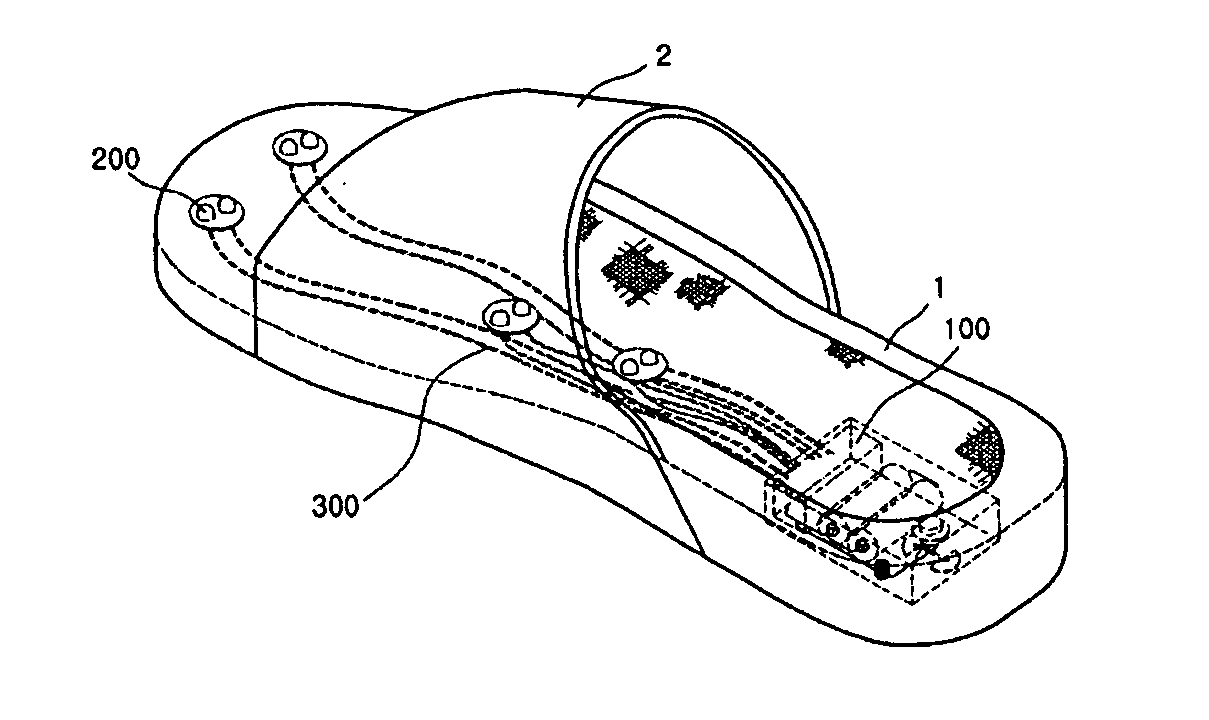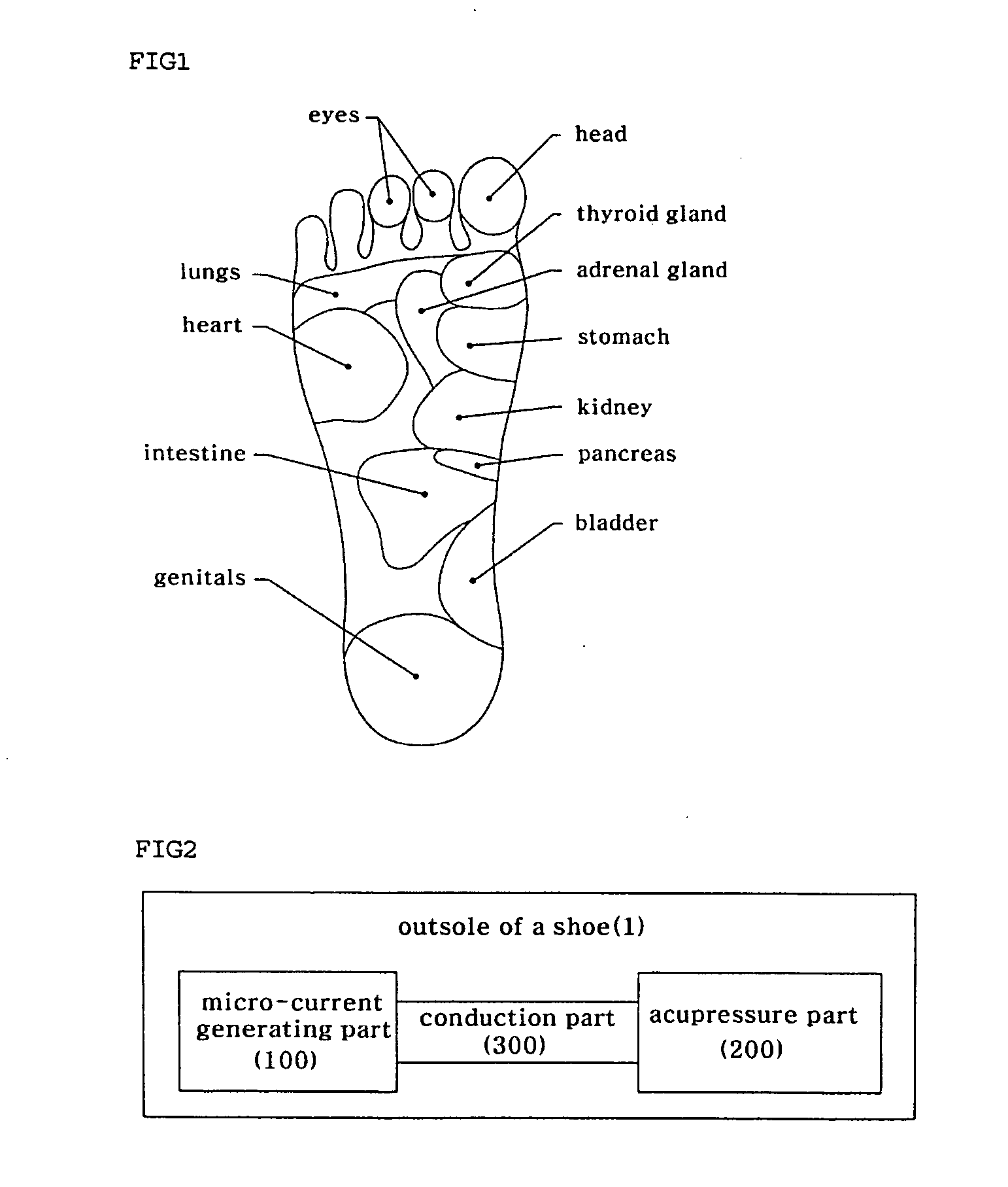Functional shoe
a functional and shoe technology, applied in the field of shoes, can solve the problems of poor health, little electricity applied, and difficult to achieve the effect of stimulating the nerve points of the sole, promoting blood circulation, and promoting health
- Summary
- Abstract
- Description
- Claims
- Application Information
AI Technical Summary
Benefits of technology
Problems solved by technology
Method used
Image
Examples
first embodiment
[0245] As shown in FIG. 22, according to this embodiment, a micro-current generating part 100 comprises a piezoelectric actuator, and is installed in an outsole 1 of a shoe.
[0246] That is, the micro-current generating part 100, an acupressure part 200, and a conduction part 300 are installed in the outsole 1. Such a construction is applicable to all kinds of shoes.
[0247] Thus, a shoe having the functional parts in the outsole 1 will be described below.
[0248] In the construction of the outsole 1, the micro-current generating part 100 is positioned in the heel portion of the outsole 1. The position is the position on the shoe where the highest pressure is applied.
[0249] Further, the heel portion of the shoe has the largest space, so that it is easy to install the micro-current generating part 100. The heel portion is a position which is capable of using force transmitted from the sole.
[0250] That is, according to this embodiment, pressure applied by the heel when walking is used ...
second embodiment
[0288] As shown in FIG. 24, according to this embodiment, an acupressure part 200 is provided in an inner sole of a shoe, and the acupressure part 200 itself has a piezoelectric actuator.
[0289] That is, the piezoelectric actuator which is the micro-current generating part 100, is embedded under each acupressure part 210, 220. By the sole pressure transmitted through the acupressure parts 210 and 220, each piezoelectric actuator is driven.
[0290] To this end, the acupressure parts 210 and 220 are installed in portions where the nerve points of the sole connected to the organs in the body are located, as in the first embodiment.
[0291] Further, each acupressure part 210, 220 is made of a conductive material. Preferably, the acupressure part 210, 220 is made of a magnet having magnetism.
[0292] The piezoelectric actuator is embedded under each acupressure part 210, 220, and the piezoelectric actuator directly acts on respective nerve points. Thus, the size of the piezoelectric actuato...
third embodiment
[0295] As shown in FIG. 18, according to this embodiment, a micro-current generating part 100 includes a battery 110, a micro-current generating circuit 120, and a switch unit 130. The micro-current generating part 100 is provided in a shoe sole 1, and so is applicable to all kinds of shoes.
[0296] That is, according to this embodiment, as a switch applying micro current, the load applied by the sole when walking is used as a contact point of the switch unit.
[0297] Further, the battery 110 and the micro-current generating circuit 120 are housed in an outer case 100a which is made of a synthetic resin material to have high strength, so that the damage to the battery 110 and the micro-current generating circuit 120 due to repeated impact loads is prevented.
[0298] Further, a manual switch 134 which controls the supply of power from the battery 110 is embedded in an upper 2 and connected to a lead wire 134a.
[0299] That is, the manual switch 134 is installed on the upper 2 of the shoe...
PUM
 Login to View More
Login to View More Abstract
Description
Claims
Application Information
 Login to View More
Login to View More - R&D
- Intellectual Property
- Life Sciences
- Materials
- Tech Scout
- Unparalleled Data Quality
- Higher Quality Content
- 60% Fewer Hallucinations
Browse by: Latest US Patents, China's latest patents, Technical Efficacy Thesaurus, Application Domain, Technology Topic, Popular Technical Reports.
© 2025 PatSnap. All rights reserved.Legal|Privacy policy|Modern Slavery Act Transparency Statement|Sitemap|About US| Contact US: help@patsnap.com



